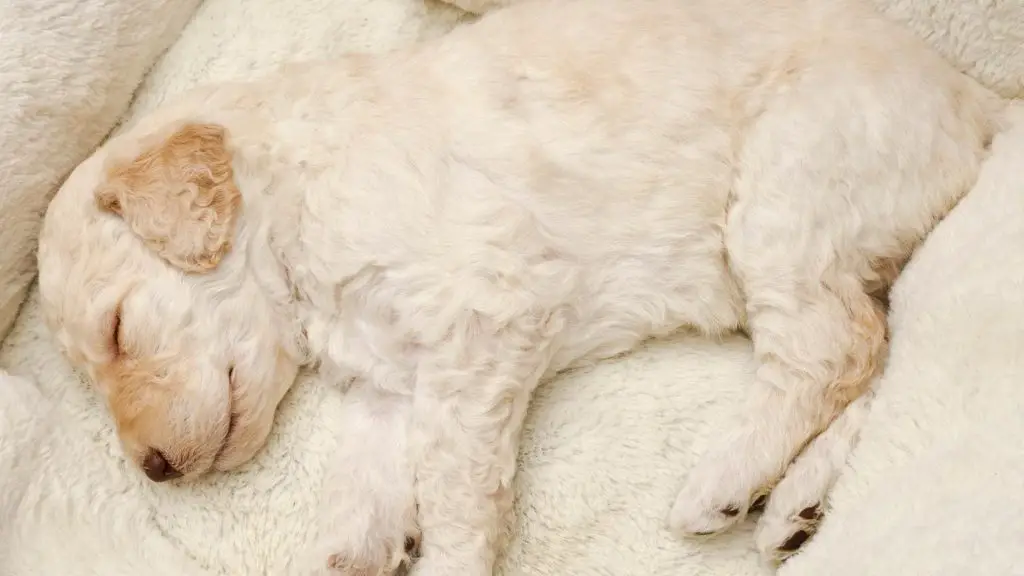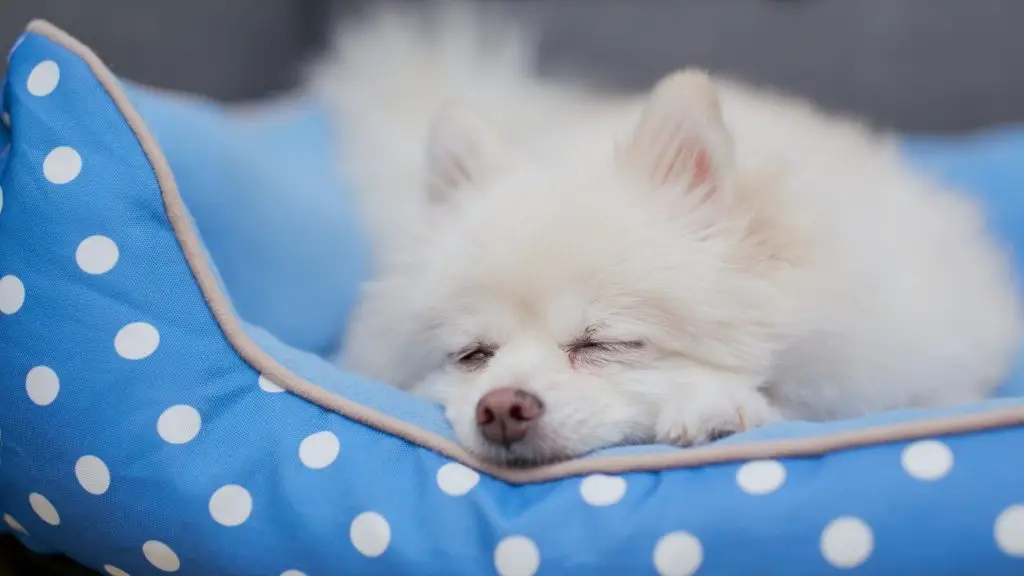Pawscessories is reader-supported. When you buy via links on our site, we may earn an affiliate commission at no cost to you.
Learn more.
We think you’d be lying to yourself if you said you didn’t love a good puppy cuddle. However, when it’s time to sleep, for both of you, it’s best that you have your own space.
Doggos really seem to know how to sprawl out to maximize their comfort when sleeping. This usually means leaving less than half the bed for you to use!
In this post we’re going to cover how to train a puppy to sleep in a dog bed.
Here are five simple steps to train a dog to sleep in their dog bed:
- Find the perfect spot for their bed in your home
- Introduce them to their bed’s location
- Come up with a command & schedule for them
- Practice, practice, practice!
- Redirection & repetition
While it’s cute at first to have your dog cuddle with you on your bed, it can soon turn disruptive as they grow and you begin getting less and less sound sleep.
It’s best to have your bed be your space, and train your puppy to sleep on their own bed that’s their space.
We’re going to dive a little deeper into these simple steps to help you figure out how to train your puppy to sleep in a dog bed.
Table of Contents

How To Train A Dog To Sleep In His Bed
Step 1 – The Set Up
Find the perfect spot for their bed. It may be a good idea to have their bed inside a crate and place a blanket over the crate to help it resemble a den.
This will help provide your pup with security and comfort.
Also a good idea would be to put a piece of your clothing (unwashed) on the bed.
This will also help them feel more comfortable as they won’t lose your scent if they’re far away from you.
If they are an especially young puppy you could also use a blanket from their litter to help calm them as well.
Step 2 – Introduction

Introduce them to their bed location and give them time to get used to it. Allow them to smell it and become familiar with it.
You can encourage them to like being in or near their bed by placing treats for them to find in their bed.
If you notice them napping during the day, softly carry them to their bed where they can continue to sleep.
If by doing this you wake them up and they immediately leave the bed don’t worry. It will take time for them to prefer this new sleeping spot.
Step 3 – Command & Schedule

Come up with a command and schedule for them to go to bed.
You want to establish a command that you will use every night to notify your pup that it’s time for bed and they need to go theirs.
For example, “bed time!”, “go to bed” or “time for bed” said in a similar tone of voice every night would work just fine.
As you say this command you’ll want to lead them to their bed and give them a treat once they get in bed.
You’ll also want to make sure you do this as close as you can to the same time every night.
Making this a part of yours and their routine will help cement this habit as quick as possible.
Step 4 – Practice
Practice! While this is a new command for your pup, it’s not a bad idea to practice during the day by saying the command, getting them in their bed and giving them a treat.
After a few days and weeks of practicing you’ll want to only use the command when it’s actually time for bed.
Step 5 – Redirection / Repetition

Redirect them to their bed if they get up during the night.
If you wake up and notice they’ve left their bed, bring them back to their bed and give them another treat.
However, make sure you don’t do this multiple times a night. If you give more than one treat you’ll be indirectly training them to get out of bed at night to get additional treats.
If they have to go number 1 or 2 during the night, once they’re back in bed a treat is a good idea to reward their behavior.
Step 6 (Optional)
Now that a few weeks have passed and your puppy is for the most part trained to sleep in their bed you can move the bed elsewhere in your home.
Some would say you want to leave the bed in the same place where you trained them, and that’s fine!
However, if you don’t want to keep their bed in your bedroom you can now increase the space between your sleeping rooms.
Things To Avoid

Being at their every beck and call!
While it’s super hard to hear them whimper or cry, if you respond by giving them love and attention every time they do so, you’re indirectly training them to do this more often to receive love.
It will be challenging for them to sleep in their own bed at first but do your best not to give in when they express this behavior.
Putting their bed in another room in the beginning.
While training them to use their own bed it’s a good idea to take baby steps.
Since they want to be close to you, putting their bed inside your bedroom is a great starting point.
As they age or as they get more comfortable sleeping in their own bed, you can start moving it elsewhere in the house.
Why Won’t My Dog Sleep In His Bed?
A dog may not sleep in their own bed for a variety of reasons. Some dog’s simply hate beds and would prefer the floor while other dogs enjoy their bed but would prefer to sleep next to you in your bed.
The main reason a dog does not sleep in their own bed is preference. They prefer to sleep elsewhere or they don’t like their dog bed.
Here is a list of reasons why your dog is not sleeping in their own bed:
- Their bed is too warm
- Their bed is too small
- They prefer other sleeping surfaces
- They want to be close to you
- Their bed is close to a vent or something they don’t like
- Their bed is associate with something negative
Is It Good For Dogs To Sleep In Their Own Bed?
It’s good for dogs to sleep in their own beds. This is because it allows them to be more independent and creates separation between you and them.
A dog that is always by their human, sleeps with them, and follows them around is more prone to develop separation anxiety. Training your dog to sleep on their own can help them build independence and confidence.
Final Thoughts
That concludes our simple steps to help you train your dog to sleep in a dog bed!
As you can hopefully now see, with a little patience and the right process, training your pup to sleep in their own bed isn’t such a daunting task.
Cuddle time is important! But so is getting a sound, night’s rest for the both of you! We wish you the best of luck in training your cuddly pup.
Other posts you might find interesting:
11 Ways To Improve Your Dog’s Listening Skills & Focus
My Puppy Won’t Stop Biting Me – I’ve Tried Everything!
Is It Too Late To Socialize My Dog? How To Socialize Adult Dog
